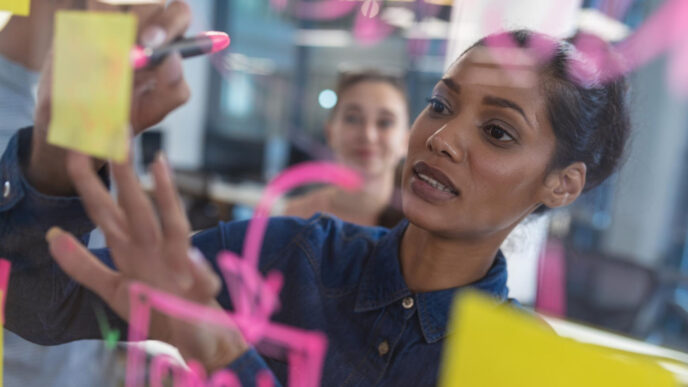Why Creative Thinking Matters in Everyday Life
You Don’t Need to Be an Artist to Be Creative
When most people hear the word “creativity,” they immediately think of painting, writing, or composing music. But the truth is, creative thinking isn’t just for artists—it’s an essential life skill that anyone can master. Whether you’re a parent solving daily household challenges, a professional navigating complex projects, or simply someone looking to improve how you think, creative thinking can be your most valuable tool.
Creativity helps us reframe problems, see fresh possibilities, and develop smarter, more effective solutions in all areas of life—from conversations to career decisions.
Creativity Is Problem-Solving in Disguise
At its core, creative thinking is about flexible problem-solving. It’s the mental habit of asking “what if?”, flipping perspectives, and exploring beyond the obvious. In everyday situations, this could mean finding a quicker route to work, organizing your schedule in a new way, or coming up with a better way to communicate with your partner. These are not artistic acts, but they are highly creative.
Consider this:
✔️ Have you ever figured out how to stretch your budget with an unconventional solution?
✔️ Or helped a child learn something difficult by turning it into a game?
✔️ Or redesigned your workspace to boost focus using what you already had?
That’s creative thinking at work.
Why You Should Train Your Creative Muscle
Creative problem-solving is not just for the big things. It’s how we handle the small stuff that adds up to major breakthroughs. Just like physical strength improves through consistent training, creative thinking gets sharper with intentional practice.
In this article, you’ll learn actionable creative thinking techniques for everyday life—no artistic background needed. We’ll explore how your brain generates new ideas, how to boost your creativity with simple strategies, and how to apply these skills in work, relationships, and personal growth.
So if you’ve ever wondered how to think more creatively or how to improve creativity skills without becoming an “artist,” you’re in the right place.
Let’s start by debunking the biggest myth about creativity—and revealing how it really works in your brain.
The Science of Creativity: How Your Brain Innovates
The Role of Neuroplasticity in Creativity
Neuroplasticity—the brain’s ability to reorganize itself by forming new neural connections—plays a crucial role in creativity. Unlike the outdated belief that intelligence and creativity are fixed traits, modern neuroscience shows that the brain is highly adaptable. Every time you learn something new, challenge yourself with unfamiliar tasks, or even daydream, you are strengthening your brain’s creative abilities.
For example, studies have shown that learning a new language, playing a musical instrument, or engaging in strategic games enhances cognitive flexibility, a key component of creative thinking. The more you expose your mind to diverse experiences, the more connections your brain can make between seemingly unrelated ideas.
Left Brain vs. Right Brain: The Real Story
The popular myth suggests that the right hemisphere of the brain is responsible for creativity, while the left hemisphere controls logic and reasoning. However, neuroscience has debunked this oversimplified model. Creativity involves both hemispheres of the brain working together.
- The left brain helps with structure, language, and analytical thinking.
- The right brain contributes to intuition, big-picture thinking, and visual imagination.
When engaging in creative thinking, your brain doesn’t rely on just one side—it activates multiple networks, including the default mode network (DMN) and the executive control network (ECN). The DMN is active during brainstorming and idea generation, while the ECN helps refine and evaluate those ideas into something practical.
The Power of Associative Thinking
One of the hallmarks of creative individuals is their ability to connect unrelated ideas, a process known as associative thinking. This is why some of the greatest innovations in history have come from unexpected intersections of knowledge.
For example:
- The invention of Velcro was inspired by how burrs stick to fabric.
- The Wright brothers studied birds to design the first airplane.
- Einstein’s theory of relativity was influenced by thought experiments about riding on light beams.
You don’t have to be a genius to use associative thinking. Simply exposing yourself to different fields of knowledge, reading diverse materials, and engaging in discussions outside your area of expertise can help train your brain to make novel connections.
How Curiosity Fuels Creativity
Curiosity is the fuel that drives creative thinking. When you ask questions, explore new topics, and challenge assumptions, you activate the brain’s dopaminergic system, which enhances learning and problem-solving abilities.
Some ways to cultivate curiosity:
✔️ Ask “what if?” and “why not?” questions.
✔️ Engage in conversations with people from different backgrounds.
✔️ Read books outside your usual interests.
✔️ Travel to new places and observe different cultures.
✔️ Experiment with unfamiliar hobbies.
By training yourself to be more curious, you create an environment where creative ideas can flourish naturally.
Unlocking Creativity in Daily Life
Reframing Problems as Opportunities
One of the most effective ways to develop creativity is to change how you perceive challenges. Instead of seeing problems as obstacles, view them as opportunities to innovate. Many breakthrough ideas come from individuals who reframe difficulties into possibilities.
For example:
- Airbnb was born from two roommates struggling to pay rent. They saw a market for renting out extra space.
- Post-it Notes were invented because an adhesive failed—it turned out to be useful for temporary notes instead of strong bonding.
When you encounter a challenge, ask yourself:
✔️ What is another way to look at this?
✔️ How can I turn this limitation into an advantage?
✔️ What would happen if I approached this from a completely different perspective?
The Importance of Playful Thinking
Many of the most creative minds, from Einstein to Da Vinci, emphasized the power of playfulness. When you engage in playful activities, your brain relaxes, making it easier to generate new ideas.
Try these playful creativity boosters:
✔️ Doodle random shapes and turn them into objects.
✔️ Free-write for 10 minutes about anything that comes to mind.
✔️ Engage in role-playing or storytelling exercises.
✔️ Play strategy or improvisation games.
Play allows you to explore without fear of failure, which is essential for creative thinking.
How Constraints Boost Innovation
Contrary to popular belief, creativity thrives under constraints. When resources are limited, the brain is forced to find new ways to solve problems. This is known as creative constraint thinking.
Some famous examples:
- Twitter (originally limited to 140 characters) forced users to communicate concisely, leading to a new form of expression.
- LEGO’s iconic bricks were designed under budget restrictions, yet they became a foundation for limitless creativity.
- Google’s homepage is minimalistic because early servers couldn’t handle a complex interface.
You can use constraints to boost your creativity by:
✔️ Setting a time limit to generate ideas.
✔️ Restricting yourself to using only a few materials or tools.
✔️ Creating solutions with minimal resources.
Simple Exercises to Stimulate Creativity
Here are some daily exercises to train your creative thinking:
- The Alternative Uses Challenge: Pick an everyday object (like a paperclip) and come up with 10+ alternative uses for it.
- Reverse Thinking: Instead of solving a problem directly, think of ways to make it worse. Then, flip those ideas into solutions.
- The 30 Circles Test: Draw 30 circles on a piece of paper and turn them into different objects in 3 minutes.
Practicing these exercises regularly will help you develop a flexible and creative mindset.
Practical Strategies to Think More Creatively
The SCAMPER Technique for Creative Problem-Solving
SCAMPER is a powerful brainstorming method that helps generate new ideas by modifying existing ones. It stands for:
- Substitute: What can be replaced? (e.g., using an app instead of paper notes)
- Combine: Can you merge two ideas? (e.g., a smartwatch combining timekeeping and fitness tracking)
- Adapt: Can you modify something to fit a new use? (e.g., turning an old suitcase into a pet bed)
- Modify/Magnify: Can you enlarge or exaggerate something? (e.g., supersized fast-food meals)
- Put to another use: Can you use it differently? (e.g., using a ladder as a bookshelf)
- Eliminate: What can you remove to improve efficiency? (e.g., removing buttons from a touchscreen device)
- Rearrange/Reverse: Can you change the order or perspective? (e.g., upside-down ketchup bottles for convenience)
Try applying SCAMPER to everyday problems, and you’ll quickly see how it unlocks fresh ideas.
Mind Mapping for Idea Generation
A mind map is a visual tool that helps structure thoughts by linking related ideas. To create one:
- Write a central concept in the middle of a page.
- Branch out with related topics.
- Keep expanding by adding sub-ideas.
For example, if brainstorming a new business idea, your mind map might start with “Online Business” and expand into categories like “Products,” “Marketing Strategies,” “Customer Needs,” etc.
The Power of Questioning and Perspective Shifts
Asking the right questions can break mental barriers and inspire new ideas. Try using these question-based techniques:
✔️ The “5 Whys” Method: Keep asking “why” to dig deeper into a problem.
✔️ What If? Scenarios: Imagine alternative possibilities (e.g., “What if money didn’t exist?”).
✔️ Different Perspectives: How would a child, scientist, or artist approach this problem?
By changing perspectives, you open new pathways for creative solutions.
How to Cultivate a Habit of Divergent Thinking
Divergent thinking is the ability to generate multiple solutions instead of settling for the first idea. To practice:
- Keep a daily idea journal and write down at least five new ideas each day.
- Engage in brainstorming sessions where no idea is judged—just listed freely.
- Challenge assumptions by asking, “What if the opposite were true?”
When you train yourself to think divergently, creative ideas will come naturally and effortlessly.
Applying Creativity Beyond Art: Work, Relationships, and Life
Creative Problem-Solving in the Workplace
Creativity isn’t just for artists—it’s essential in professional settings. Companies that foster creative thinking tend to innovate faster and adapt better to change. Some ways creativity enhances work performance include:
✔️ Finding unique solutions to operational challenges.
✔️ Enhancing collaboration by encouraging diverse perspectives.
✔️ Improving efficiency through unconventional workflows.
For instance, Google’s “20% time” policy, which allows employees to work on passion projects, led to innovations like Gmail and Google Maps. You can apply this principle by dedicating time to brainstorming and experimenting with new ideas in your work.
How Creative Thinking Improves Communication
Communication isn’t just about words; it’s about delivering ideas effectively. Creativity helps you:
✔️ Craft compelling messages that engage your audience.
✔️ Use storytelling to make information more relatable.
✔️ Adapt your communication style based on your audience’s needs.
For example, great speakers often use metaphors and humor to make their points memorable. You can improve your communication skills by experimenting with different tones, structures, and delivery methods.
Innovation in Personal Development and Decision-Making
Creativity is key to self-improvement. Whether setting goals or making decisions, thinking creatively can help you:
✔️ Explore unconventional career paths.
✔️ Overcome limiting beliefs by considering alternative perspectives.
✔️ Develop resilience through adaptive thinking.
For example, Steve Jobs credited a calligraphy class for influencing Apple’s design philosophy. Small creative experiences can lead to big personal breakthroughs.
Turning Creativity Into a Lifelong Advantage
The most successful individuals—whether in business, science, or leadership—embrace creativity as a lifelong skill. Here’s how you can too:
✔️ Stay curious—always ask questions and seek new experiences.
✔️ Take creative risks—don’t be afraid to try unconventional approaches.
✔️ Keep learning—expose yourself to different industries, cultures, and ideas.
Creativity isn’t about talent; it’s about mindset. By integrating creative thinking into your daily life, you can unlock endless possibilities and enrich both your personal and professional experiences.
References and Inspirational Resources
- Sawyer, Keith. Zig Zag: The Surprising Path to Greater Creativity. Jossey-Bass.
- Csikszentmihalyi, Mihaly. Creativity: Flow and the Psychology of Discovery and Invention. Harper Perennial.
- Runco, Mark A. Creativity: Theories and Themes: Research, Development, and Practice. Academic Press.
- Psychology Today – Articles on problem-solving and everyday creativity.
- Harvard Business Review – Resources on creative thinking and innovation in the workplace.
- The American Psychological Association – Research on cognitive flexibility and divergent thinking.















